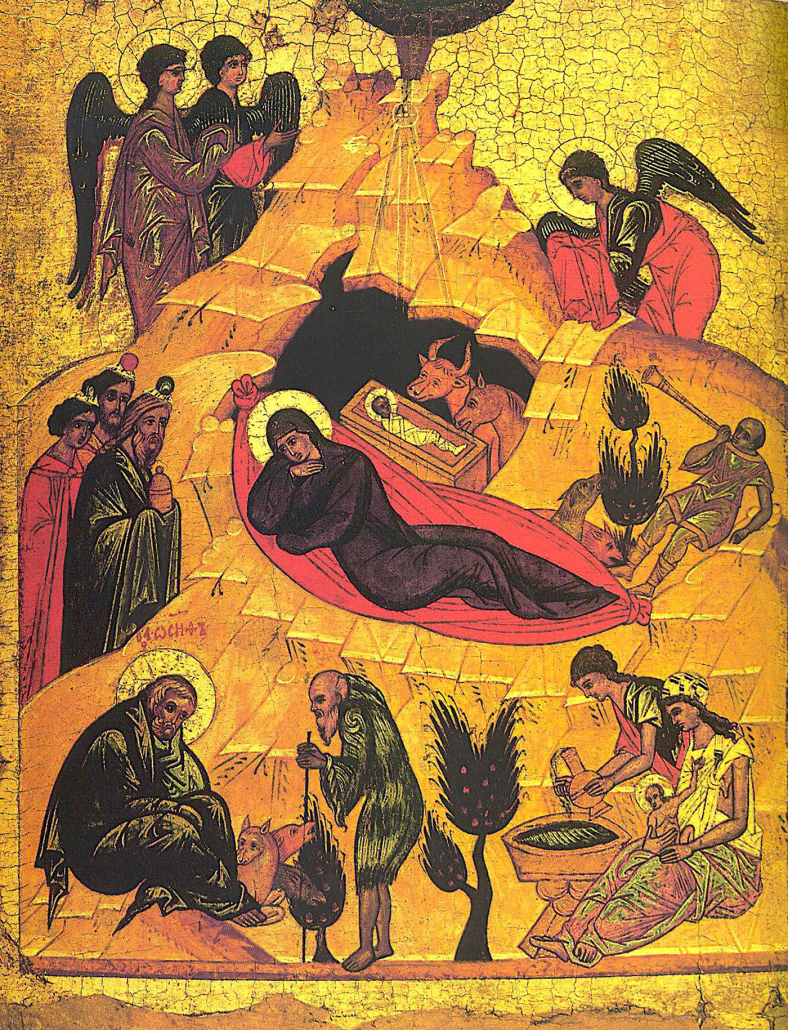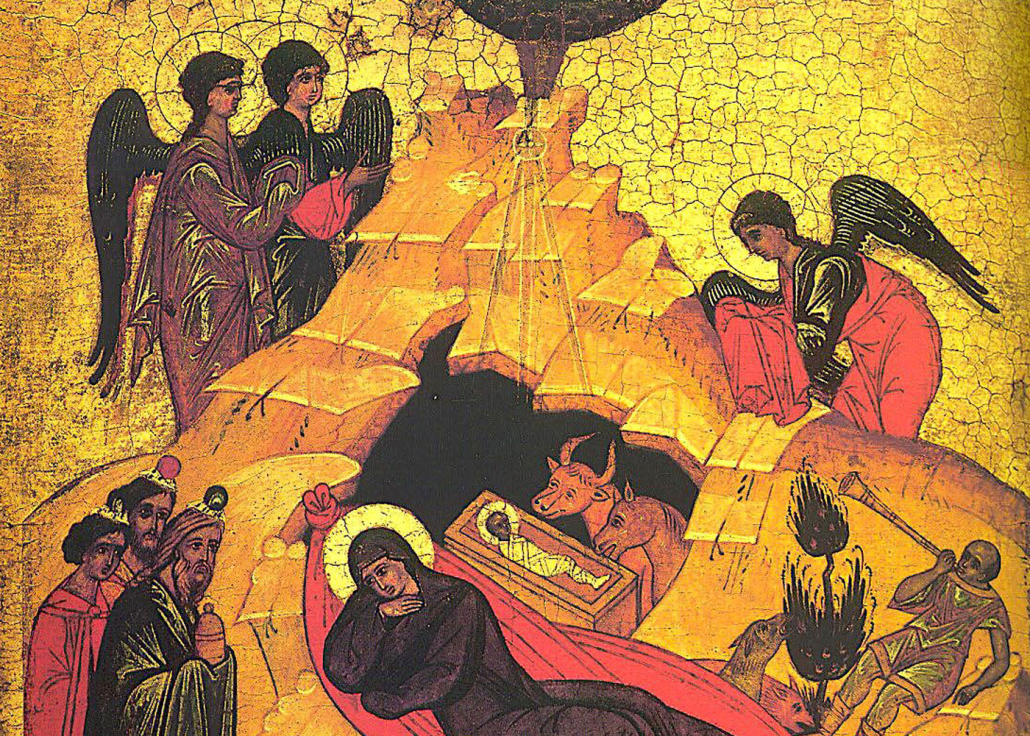Image: Icon of the Nativity (detail), Andrei Rublev, c. 1405.
‘Five gold rings’
Andrew Collis
Christmas 1, Year C
1 Samuel 2:18-20, 26; Psalm 148; Colossians 3:12-17; Luke 2:41-52
“On the fifth day of Christmas my true love gave to me … five gold rings …” Allegedly, the popular 18th-century carol was a means of teaching the faith, the five gold rings represented the five books of the Torah.
Our gospel shows Jesus (not unlike the young Samuel) in the Temple, discussing and debating Torah.
The five gold rings, for us, today, can represent five figures in the Christmas story. Andrei Rublev’s 15th-century icon of the Nativity highlights five, at least five. There are five gold rings depicted, five haloed/hallowed figures.
1. The Christ-child is a small, haloed figure at the centre (he is also shown with the midwives at the bottom right).
The Christ-child is a small, haloed figure. Perhaps you think of figures in the community – softly spoken, newly arrived. How brave and bold to knock and to enter.
Perhaps you think of seemingly insignificant developments, improvements … A new artwork (like the drawings by Esme and Hamish), a wreath, a Christmas tree, a floral arrangement. Myriad small gestures of welcome, kindness, respect, affection, determination …
The Christ-child is in a cave. He is depicted in burial clothes (already the rejected and persecuted One, already the crucified and risen Saviour). The Easter mystery lies within the Christmas story. T.S. Eliot’s poem, “The Journey of the Magi”, reflects on natality and mortality: “… this Birth was / Hard and bitter agony for us, like Death, our death …”
We miss our friend Cathie … We honour her life and memory. We acknowledge our own mortality. And we experience, in the vicinity of the Christ-child, a dying to certain comforts, conventions – notions of entitlement, even happiness at the expense of others (various forms of violence).
Perhaps it is then that we notice the ox and the ass, symbolic of Jewish and Gentile cultures (and therefore reconciliation), but primarily representing the non-human world …
The midwives (at bottom right) signify the full humanity of Christ. Humanity entails animality – dependence on food and drink, a capacity for suffering, learning, communication, relationship, play …
2. Mary (Theotokos, Mother of God), a large, haloed figure, looks toward Joseph with grace, assurance. Mary is the model for all the saints. According to Luke’s gospel, she is a protest singer in the tradition of the prophets. Her “yes” to the angel affirms her part in a wider social, even cosmic, plan.
I hear Mary’s voice … prophetic, expansive … courageous, trusting …
Alice Skye (Anderson) is a Wergaia and Wemba Wemba artist – a musician and writer: “I stand on the back step to breathe,” she writes/prays. “The way the air smells and the trees sound / The way the mountains feel like company – / big personality / We talk a little but not out loud // Spoke to my Aunty on the phone last night, / she apologised for talking too much / I hope she never stops …” (Words to Sing the World Alive).
3. The third haloed figure, Joseph, it seems, has left the cave. Tormented by doubts, he has walked away. Can it be that salvation comes by way of such a family? This is not the family setting he has had in mind. The figure beside Joseph is the Devil, the tormentor. The Devil says, “Mary is unworthy of your protection. The child is not born of God/Love.”
But Joseph, like his namesake and fellow dreamer in the Torah (Genesis 37), will choose goodness. He will protect and elevate Mary. He will nurture and raise the Christ-child. He will stand firm.
I imagine Joseph returning to the cave, rejecting devilish lies, intent on realising the truth of his dreams, intent on realising his dreams in troth.
Early church sources see the cave, its chambers and dark mysteries, as a symbol of the heart. Joseph returns to his heart. In the depths of his heart, he finds Christ. Such an approach opens the icon to personal reading.
What frightens me and makes me walk away from my own sense of truth, my own commitment to love? What doubts trouble me? In what way am I tempted to anger, to abandon as unworthy the ones with whom I share life? My own family (however unconventional)? What might a prayerful return to the heart mean for me?
This question of prayerful return invites careful and creative response. Find a way to pray – at the piano, in the silence, swimming, drawing or collaging, gardening or cooking, reading or writing. Not as a means of productivity (work comes later), but something more like receptivity – rest, maintenance. Prayer means return to a state of wonder. And you, too, will find Christ there.
4. The fourth haloed figures are the angels, shown above the magi and the shepherd. What can we say about them (in addition to their love for singing)? There is something to be said about the extraordinary in the everyday.
The magi represent the search for wisdom. Angels accompany those who search for wisdom. Wherever the search leads – across cultural and religious barriers, along astronomical and mathematical paths.
The shepherd represents the worker, the labourer in the field, in the mine, on the building site, in the factory, in the office. Most pointedly, the shepherd represents the poor worker, the worker without security, safety. And the icon teaches that angels accompany those who are most poor. This is not a sentimental meaning, but liberationist. The gospel is first of all good news for the poor – good news for the oppressed and distressed.
5. Lastly, there is a subtle halo just above the cave, with three lines pointing to the Christ-child. The mysterious figure above the small halo is called a mandorla (Italian for “almond”). The almond-shaped figure symbolises the divine.
Why almond-shaped? The almond tree flowers first, as early as mid-winter in some places. There is also the story, in the Torah, of Aaron the priest whose staff blossoms forth both flowers and almonds (Numbers 17:8). The mandorla, then, means new life, surprising new life.
It also signifies the presence and glory of God beyond vision and words.
We encounter a God we cannot comprehend. We apprehend a Love we do not grasp or possess. To borrow a phrase from a near-contemporary work, we enter a “cloud of unknowing”. We experience True Love as a Gift of life and new life.
Five gold rings. Praise be to God – Silence, Word, Holy Life. Amen.

Image: Icon of the Nativity, Andrei Rublev, c. 1405.




